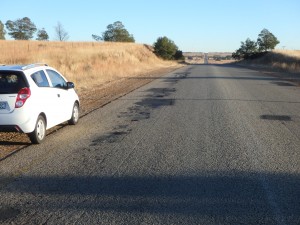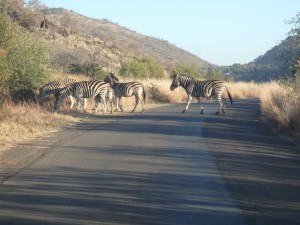Matsushima June 18th.
http://cowmanauction.com/auctions/page/5/  I can barely write I’m so exhausted. Catherine and I planned to start our road trip today down to the Cape of Good Hope, but instead we decided to take a day trip north, to Pilanesberg National Park, and set out on the long trip tomorrow. Marianne said it would be a two hours’ drive to Pilanesberg, but that is perhaps with Dirk driving. It took us almost five hours to get there and four more hours to drive back. Driving on the other side of the road, and working a stick with my left hand for the first time, took a fair amount of concentration, and having my first try at it be a nine-hour driving day was probably unwise. We wasted much time in the early part of the day looking for a road map: they are not available at gas stations, and apparently nowhere else either. We were hence at the mercy of signage, which at times simply was not there. It was worst close to the National Park, whose gates were not signposted, and so we drove past two of them not even knowing what they were. We also missed one turn and almost ended up in Botswana. We entered a few private game parks – we thought that might mean we were close to the National Park – they went on for awhile (we had already missed the turn), then the road went down to one lane (for two directions), which we found odd going to a major tourist destination (we were told this park is so crowded as to be “urban”), and then the road went unpaved entirely, going through the poorest, most desolate village we’ve seen here. We stopped and asked directions and were turned back. We were admittedly still probably thirty miles from the border, though I don’t know, because we still don’t have a map.
I can barely write I’m so exhausted. Catherine and I planned to start our road trip today down to the Cape of Good Hope, but instead we decided to take a day trip north, to Pilanesberg National Park, and set out on the long trip tomorrow. Marianne said it would be a two hours’ drive to Pilanesberg, but that is perhaps with Dirk driving. It took us almost five hours to get there and four more hours to drive back. Driving on the other side of the road, and working a stick with my left hand for the first time, took a fair amount of concentration, and having my first try at it be a nine-hour driving day was probably unwise. We wasted much time in the early part of the day looking for a road map: they are not available at gas stations, and apparently nowhere else either. We were hence at the mercy of signage, which at times simply was not there. It was worst close to the National Park, whose gates were not signposted, and so we drove past two of them not even knowing what they were. We also missed one turn and almost ended up in Botswana. We entered a few private game parks – we thought that might mean we were close to the National Park – they went on for awhile (we had already missed the turn), then the road went down to one lane (for two directions), which we found odd going to a major tourist destination (we were told this park is so crowded as to be “urban”), and then the road went unpaved entirely, going through the poorest, most desolate village we’ve seen here. We stopped and asked directions and were turned back. We were admittedly still probably thirty miles from the border, though I don’t know, because we still don’t have a map.
We saw the shantytowns today – the “townships” or settlements. Blacks were required to live there in the apartheid years, and today they still live there, I suppose because that is where their home was before. In terms of housing, from what I saw today, I would have to guess that South Africa in 2015 differs from apartheid South Africa only by percentage points. Vast numbers of people in the country live in ten-foot-wide corrugated metal shacks in shantytowns on the outskirts of the towns. I figured this was true in Johannesburg. It was true in every single town we saw today: the center of the town looks a bit graceless but modern, like the center of a small city in Greece. And as you drive out, the shantytowns begin. Some are tiny brick houses, and there seems to be a kind of hierarchy among the townships: some with brick houses, some with metal shanties (I don’t know if this is the government’s work, to replace corrugated metal with brick, but the result of it is just to write apartheid in letters of masonry on the ground). Most of these areas, twenty years after the election of Mandela, don’t even have a paved walkway (much less bus service) into town, where all the jobs are. At the beginning and end of the day there is a stream of people walking the two or three miles from town to township.

You drive until you see animals, and then you stop and watch them: Pilanesberg National Park. It's really quite lovely.
It was in this context that we saw Pilanesberg National Park. It was amazing – it was delightful. We were warned it would probably be busy – there was no one there. We paid our admission – $17 for two people, including a good booklet identifying the animals – and got to drive around all by ourselves, no guides, no cheesiness, just the two of us and the animals. And they were there – it was impossible to believe there could be so many large animals supported by a land so dry. Wildebeest, wart hogs, zebras, impalas, kudus, elands, two rhinoceroses, cape buffalo, several giraffes, a crocodile, fishing eagles, all kinds of other birds, what looked like a serval, and even an elephant at the end of the day. It was magical. Other animals are in the park but we did not see them – lions, leopards, baboons. But compared to the driving, it felt almost the opposite of what I might have thought: I felt that out there, outside the park, was wilderness, was danger, was fear and unpredictability, while here, with the wild animals, there was peace and tranquillity. The wilderness areas are a respite from the wildness that is man’s inhumanity to man.
Driving back through Rustenburg we stopped at a light. Ahead of us was a large pickup truck, its bed literally piled with men in winter coats and hats and gloves coming home from work, perhaps fifteen of them in the bed of one truck. As the light turned I caught one of the young men in the truck staring at me, with my new car, neat clothes, and pretty wife. In his eyes I saw hatred. I looked away and reached for the gearshift. I didn’t really know how else to react.
As we drove through a particularly deserted area there was a sign right before a stop sign which read: “Hijack Area 500m.” I presumed this means you don’t have to take the stop sign too literally in that spot. Catherine had been particularly alert and attentive while in that area, which was good, because when we returned to it after nightfall, she recognized the stop sign from the other side, even though there was neither stop sign nor directional sign going the other way. Missing that turn would have put us on the wrong side of a mountain, and in the dark night – and it is very dark here – who knows how we would have righted ourselves.
I had a runny nose yesterday, and it’s a fever now. I drove most of the way home with an intense fever. I will be glad to sleep tonight. I bought two aspirin at the National Park store, and just took them – aspirin breaks fevers, for me, but it also makes me tired, and I wanted to refrain from them until bedtime. Now I plan on sweating out the fever. Tomorrow we head across the interior deserts to Kimberley.
Post a Comment